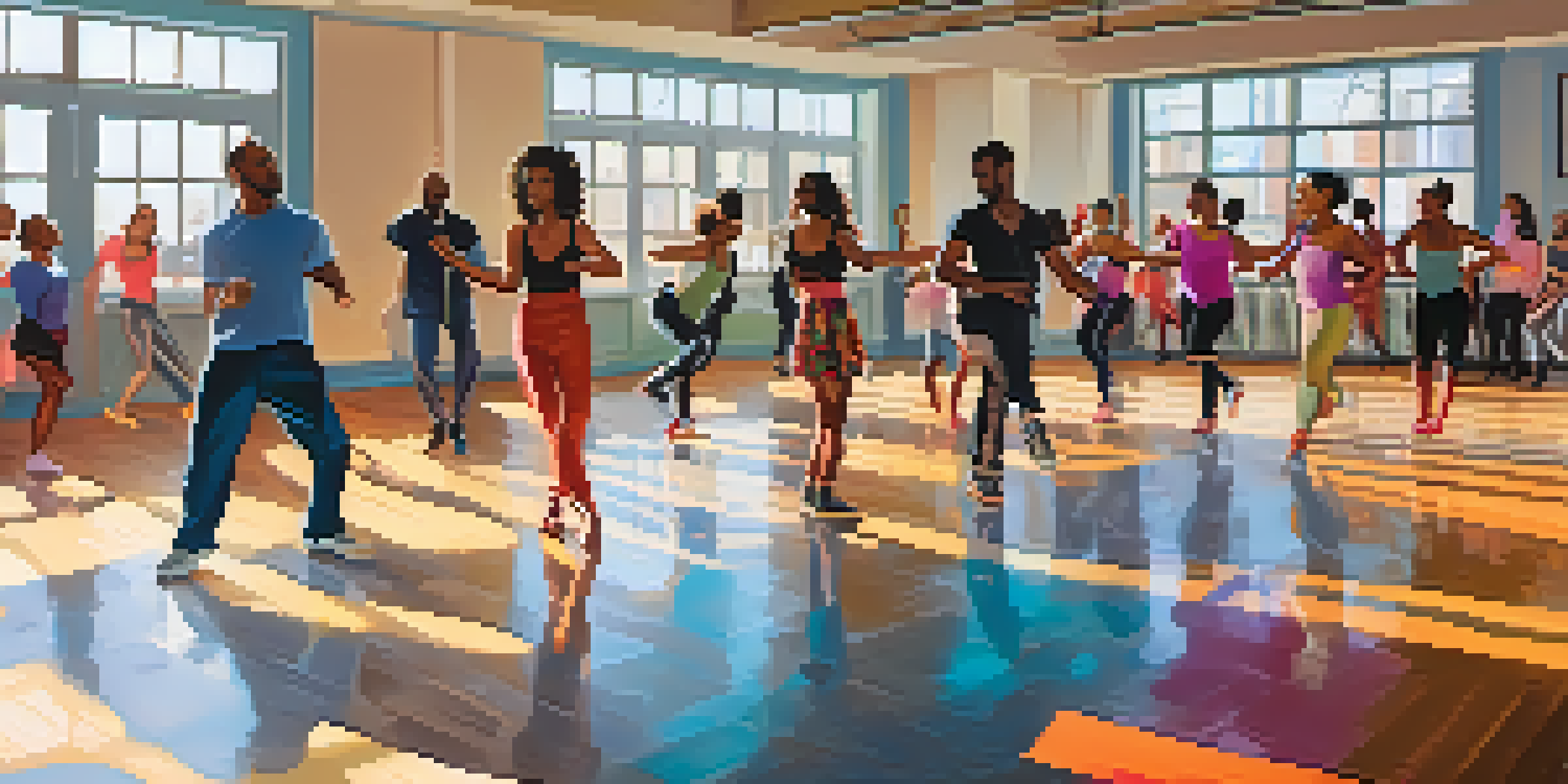Dance and Cognitive Function: Keeping the Mind Sharp

The Connection Between Dance and Brain Health
Dance is not just about rhythm and movement; it’s a powerful workout for the brain. When you dance, you engage in a complex set of tasks that require memory, coordination, and concentration. This multi-tasking ability can help improve cognitive function, making it an enjoyable way to keep your mind sharp.
Dancing is like dreaming with your feet!
Research has shown that physical activities like dance can stimulate the release of neurotrophic factors, which are proteins that promote neuron growth and survival. This means that not only does dance improve your physical fitness, but it also contributes to brain health. Engaging in dance regularly can potentially delay cognitive decline as you age.
Think of dance as a fun puzzle for your brain. Each routine requires you to learn new steps, remember sequences, and adapt to different rhythms, which keeps your mind agile. Just like solving a crossword puzzle, the process of learning and performing dance can strengthen your cognitive skills.
How Dance Improves Memory and Learning
Learning new dance steps is a fantastic way to enhance memory. The process of committing intricate movements to memory requires focus and repetition, which are key elements in improving overall cognitive function. This form of learning is not only enjoyable but also effective in sharpening your mind.

For example, think about a dance class where you’re learning a new routine. As you practice, you’re not just memorizing steps; you're also fostering connections in your brain that aid in memory retention. The more you dance, the more these connections strengthen, leading to improved memory in other areas of your life, too.
Dance Boosts Brain Health
Engaging in dance enhances cognitive function by improving memory, coordination, and concentration.
Moreover, dance often involves social interaction, which is another beneficial factor for memory enhancement. Engaging with others while learning or practicing a dance routine can create additional cognitive challenges that further stimulate brain activity. This social component adds another layer of mental exercise, making dance a well-rounded activity for cognitive health.
The Role of Coordination in Cognitive Function
Coordination is essential in dance, and it plays a significant role in cognitive function. When you dance, you're not just moving your body; you're synchronizing your movements with music and rhythm. This requires your brain to process information quickly, enhancing your ability to coordinate complex tasks.
To watch us dance is to hear our hearts speak.
As you learn to combine your body movements with music, you develop new neural pathways that facilitate better coordination and balance. This is similar to training your brain to handle multiple tasks at once, which is a valuable skill in everyday life. Improved coordination can lead to better performance in other activities, both physical and mental.
Think of it this way: when you’re practicing a dance routine, your brain is like a conductor leading an orchestra. Each movement must align perfectly with the beat, and any slight misstep can disrupt the harmony. This constant practice of coordination can translate to sharper reflexes and smoother cognitive functioning in daily tasks.
Dance as a Stress Relief Tool
In addition to cognitive benefits, dance serves as an excellent stress relief tool. When you dance, your body releases endorphins, the feel-good hormones that can elevate your mood and reduce feelings of anxiety. This emotional boost can lead to clearer thinking and improved cognitive performance.
Imagine coming home after a long day, feeling overwhelmed. Putting on your favorite music and dancing around your living room not only lifts your spirits but also helps clear your mind. This release of built-up tension can create a mental space where you can think more clearly and creatively.
Social Interaction Enhances Learning
Dancing with others promotes mental engagement and quick thinking, contributing to better cognitive resilience.
Moreover, the rhythmic movements involved in dance can have a meditative effect, allowing you to focus on the present moment rather than your worries. This mindfulness practice is beneficial for cognitive function, as it encourages a calm and focused mind, ready to tackle challenges more effectively.
The Social Benefits of Dancing for Cognitive Health
Dancing is inherently a social activity, and the benefits of social interaction contribute significantly to cognitive health. Engaging with others while dancing fosters a sense of community and belonging, which can enhance mental well-being. This social engagement is crucial for maintaining cognitive function as we age.
When you dance with a partner or in a group, you're not only enjoying the physical activity but also stimulating your brain through conversation and teamwork. These interactions can help you stay mentally sharp by requiring quick thinking and adaptability, skills that are essential for cognitive resilience.
Consider a dance class where you're learning with friends. The laughter, shared experiences, and support create an uplifting environment that promotes mental engagement. This social aspect of dance not only makes it enjoyable but also serves as a protective factor against cognitive decline.
The Neuroplasticity Benefits of Dancing
Dancing promotes neuroplasticity, which is the brain's ability to reorganize itself by forming new neural connections. This adaptability is crucial in maintaining cognitive function, especially as we age. By engaging in dance, you encourage your brain to grow and adapt, which can lead to improved memory and learning capabilities.
As you learn new dance styles or routines, your brain is constantly challenged to create new pathways. This is similar to how learning a new language or instrument stimulates cognitive growth. The more you push your brain through dance, the more resilient and agile it becomes.
Dance Reduces Stress Effectively
The endorphins released while dancing help alleviate stress and promote clearer thinking.
Think of neuroplasticity as a muscle; the more you use it, the stronger it gets. By regularly participating in dance, you’re effectively giving your brain a workout, enhancing your cognitive abilities and ensuring that you stay mentally sharp for years to come.
Getting Started with Dance for Cognitive Benefits
If you’re looking to reap the cognitive benefits of dance, getting started is easier than you might think. You don’t need to be a professional dancer; just find a style that resonates with you. Whether it’s salsa, ballroom, hip-hop, or even a simple dance workout video at home, the key is to enjoy the movement.
Consider joining a local dance class or online community to find like-minded individuals. The social aspect of dancing can enhance your commitment and make it a more enjoyable experience. Plus, learning with others can provide motivation and encouragement, making it easier to stick with it.

Lastly, remember that the goal is to have fun. Dance should feel liberating and joyful, not like a chore. So, put on your favorite tunes and let yourself move; your brain will thank you for it!